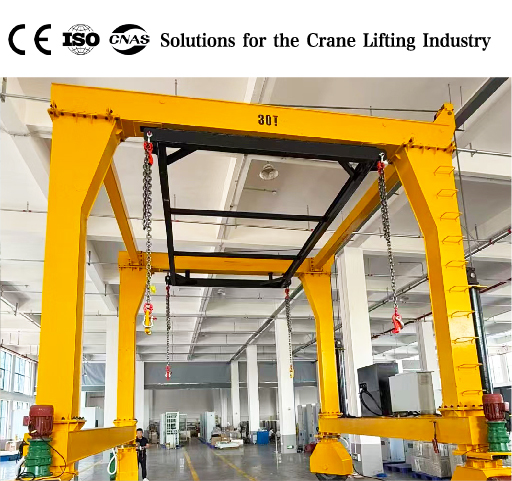In global trade and cargo handling, the
container gantry crane stands as a critical asset—powering efficient loading, unloading, and stacking of shipping containers in ports, yards, and intermodal hubs. As businesses seek to streamline supply chains and reduce turnaround times, understanding the types, key functions, and selection criteria of container gantry cranes becomes essential. This guide breaks down everything you need to know about this heavy-duty equipment, from core configurations to maintenance best practices.

A container gantry crane is a large-scale lifting device designed exclusively for handling standard shipping containers (20ft, 40ft, or 45ft units). Unlike general-purpose cranes, it features a portal-shaped structure (with legs supporting a horizontal beam) and is engineered to move along fixed rails or rubber tires, enabling precise positioning of containers. Its high load capacity (typically 40–80 tons, with heavy-duty models up to 120 tons) and tall lifting height make it indispensable for dense container storage and cross-modal cargo transfer.
Not all container gantry cranes are the same—each type is optimized for specific environments. Below are the most common configurations, along with their ideal applications:
- Design: Moves along fixed ground rails, ensuring stable operation and consistent path alignment.
- Advantages: High stacking height (up to 6–8 containers tall), fast travel speed, and low operational costs (no tire maintenance).
- Best For: Large container yards, port terminals, and intermodal facilities with fixed cargo flow routes. For example, Yangyu Rail-Mounted Container Gantry Cranes are widely used in Chinese ports to handle 500+ containers per day per unit.
- Design: Equipped with heavy-duty rubber tires for flexible movement (no rails required).
- Advantages: Versatile—can adjust to changing yard layouts; ideal for small to medium yards with dynamic cargo needs.
- Best For: Inland container depots, warehouse yards, and temporary cargo hubs where rail installation is impractical.
- Design: Installed along port quaysides, with a long outreach to reach containers on ships (up to 20+ containers wide).
- Advantages: Directly loads/unloads containers from vessels to trucks or yard cranes; high throughput (15–25 containers per hour).
- Best For: Deep-sea ports and coastal terminals (e.g., Shanghai Port, Rotterdam Port) handling large container ships.
The role of container gantry cranes extends beyond basic lifting—they are a catalyst for supply chain efficiency. Here’s how they drive value:
-
Boosts Cargo Turnaround Speed:
Automated or semi-automated container gantry cranes reduce manual labor and cut handling time by 30–50% compared to traditional cranes. This is vital for ports aiming to minimize ship berthing time (a key cost factor for shipping lines).
-
Maximizes Yard Space:
With stacking heights of 6–10 containers, these cranes use vertical space efficiently—doubling or tripling storage capacity in dense yards. For example, a 10,000-square-meter yard with RMGCs can store 2,000+ containers, vs. 800 with manual stacking.
-
Ensures Safe & Precise Handling:
Advanced features like anti-sway systems, load sensors, and remote operation reduce accident risks (critical for heavy containers). Modern models also comply with ISO safety standards, minimizing damage to cargo and equipment.
-
Supports Intermodal Transportation:
Container gantry cranes seamlessly transfer containers between ships, trucks, and trains—bridging sea, land, and rail transport. This is essential for “door-to-door” supply chains, such as moving electronics from Chinese factories to European warehouses.
Selecting a container gantry crane depends on your operational needs. Use these criteria to make an informed decision:
- Load Capacity: Match the crane’s capacity to your typical container weight (e.g., 40ft containers weigh ~22 tons empty, 30–40 tons loaded). Opt for a 50–60 ton model for flexibility.
- Operational Environment: Choose RMGCs for fixed rails/long-term yards; RTGCs for flexible layouts; STS cranes for quayside ship handling.
- Automation Level: Basic models use manual operation; mid-tier options offer semi-automation (e.g., auto-positioning); high-end cranes feature full automation (integrated with yard management systems).
- Brand & After-Sales Support: Prioritize reputable manufacturers (e.g., Yangyu, Konecranes, Liebherr) that offer global maintenance services—downtime for cranes can cost $10,000+ per day.
Proper maintenance is key to avoiding costly breakdowns. Follow these best practices:
- Daily Inspections: Check tires/rails for wear, lubricate moving parts (e.g., hoists, gears), and test safety systems (brakes, anti-sway).
- Monthly Servicing: Inspect electrical components (cables, motors) and adjust tension on lifting ropes.
- Annual Overhauls: Hire certified technicians to assess structural integrity, replace worn parts, and update software (for automated models).
- Train Operators: Ensure staff are trained on safe operation and basic troubleshooting—human error is a top cause of crane damage.
A container gantry crane is not just equipment—it’s an investment in supply chain resilience. By choosing the right type, prioritizing automation, and following strict maintenance schedules, businesses can reduce costs, improve efficiency, and stay competitive in global trade. Whether you’re a port operator, logistics provider, or warehouse manager, partnering with a trusted supplier to tailor a crane to your needs will deliver long-term value.
Ready to optimize your container handling? Contact a professional crane manufacturer today to get a custom quote and technical consultation.
Post Views: 6
